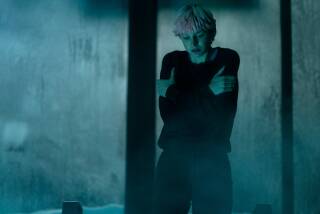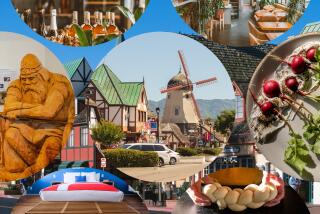Sweden preserves its Old World charms

- Share via
Reporting from Tallberg, Sweden — As I examined a map of central Sweden, place names seemed oddly familiar: Siljan … Leksand ... Rattvik. ... Had I been here in another life?
No. I’d simply been shopping at Ikea. A number of the firm’s wares are named after Swedish cities. And yet, that wouldn’t be the strangest sensation I’d encounter here in Tallberg.
This village of 217 souls is tucked into the Dalarna region, in the country’s heartland. Mention to Stockholm citizens that you are headed for Dalarna, and they’re likely to sigh, “Ahhh, the most Swedish place in Sweden!”
Three hours northwest of Stockholm by train or car, you venture back in time from the hip, modern capital to a land steeped in folklore. With its tidy buildings painted a deep red and trimmed in white, Tallberg seemed suspiciously like a quaint theme park.
At the front desk of the Akerblads hotel, my husband and I were greeted by a blond, apple-cheeked young woman in a flower-embroidered, puffy-sleeved, dirndl-skirted outfit. She wore her costume without a trace of the irony an American of similar age would surely exude.
The hotel’s main building is the oldest farmhouse in Tallberg, dating to the 15th century, and the 19th, 20th and 21st generations of the original family still operate the business. In the restaurant, portraits of various stern Akerblads ancestors scowl at diners, a contrast with sprightly painted folk designs that decorate the room.
I began to realize that the folk atmosphere of Dalarna wasn’t a re-creation for the benefit of tourists but a way of life that has changed little over the years. It’s not at all unusual for locals to wear traditional dress at church, and towns still own the sleek oared vessels known as church boats, once the only means worshippers had to travel across Lake Siljan to Sunday services. Today, the long wooden boats, typically with 10 pairs of rowers, can be seen in summertime races and midsummer events.
A five-minute stroll took us to the lake, where the gentle, undulating shoreline belies the body of water’s violent origin — it was formed more than 375 million years ago when a meteorite 11/2 miles in diameter crashed to Earth. All is peaceful now, and we watched a few brave swimmers stroking through the clear, chilly waves.
Contemplating the calm scene, I started to ease into the Dalarna mind-set. It felt a bit like being in a fairy tale. Cows grazed in lush pastures crowded with delicate wildflowers — meadows so dense with diverse plant life that 10 square feet can contain 60 species. It all seemed fit for a fable.
Fortunately, the organizers of my husband’s conference had provided some local “fairy godmothers” to entertain those not taking part in official events. These kind women showed us the area sights, from an artist’s modest yet astonishingly decorated cottage to a massive quarry-turned- opera venue.
I had never heard of Carl Larsson before visiting his home in Sundborn, about an hour’s drive southeast of Tallberg. His paintings of family life at the turn of the 20th century are similar to Norman Rockwell’s work, but with an Arts and Crafts sensibility. His real masterpiece, though, is the ever-expanding cottage where he lived with wife Karin and their seven children.
The couple amassed a collection of decorative items spanning centuries and put their own stamp on everything. In an era when furnishings were dark and serious, the Larssons splashed their house with turquoise, sunflower yellow and poppy red, filling it with clean-lined furniture they designed themselves. Their aesthetic is as stunning as Frank Lloyd Wright’s or Gaudí’s.
The Larssons kept adding on to their abode, including a miner’s cottage Carl rescued to preserve its flowing paintings of religious themes and foliage, dating to 1742, that covered the walls and ceiling.
Carl painted rooms with garlands and thought nothing of covering a Baroque-era cupboard with a portrait of his daughter Brita or swathing an antique spice cabinet in jaunty colors, with an elegant gold inscription reading, “Karl Larrson bought this old cabinet to put junk and other things in.”
Karin wove tapestries and textiles in Art Nouveau patterns evoking Japanese block prints and stylized bits of nature. The couple was a touchstone for Swedish art and design, and their house continues to inspire today’s designers.
To see how more conventional, well-to-do folk lived about that time, we drove about 15 minutes from Tallberg to Leksand and the Munthe’s Hildasholm museum, a 1911 house built by a physician to the Swedish royal family. The house contains fine antiques but seems ordinary compared with the Larssons’ home until you see the dazzling collection of tiny marionettes and stage sets created by Munthe’s wife and children. Chinese sages, choirboys, ballerinas, courtiers and more once cavorted in their amateur productions.
In another example of local creativity, the Dalarna countryside comes to life on fabrics printed by hand at the Jobs Handtryck studio in Vastanvik, about 12 miles south of Tallberg. But these aren’t delicate, Laura Ashley-style country prints. Their vibrant colors and bold graphics (one bestseller features rhubarb plants) have little in common with those dainty designs. A studio tour lets you watch bolts of cloth being stenciled with as many as 16 colors on two 100-foot-long tables. In the outlet shop, a range of chic products — pillows, purses, trays, chairs — is available in patterns that date from 1944, when the family business was founded, to the present.
In the village of Nusnas, near Mora, you can visit two workshops to watch Dala horses being made. These colorful steeds, also known as Dalecarlian horses, are the symbol of Dalarna. Most are carved by men, then decorated by women with flourishes of flowers. You’ll see them everywhere: brightly painted, blocky wooden horses of every size (some villages even have a large version displayed as their mascot). At the Dalarnas Museum in Falun, about 30 miles from Tallberg, you can see a herd of historic horses.
I skipped the cold, clammy depths of the Falun copper mine, where copper was extracted for more than12 centuries, but I did venture nearly 200 feet down into a limestone quarry near Rattvik. Now transformed into the massive Dalhalla amphitheater, it’s renowned for opera. The stage is set amid an emerald lake at the quarry’s base, and entertainers often make a grand entrance by rowboat. One diva disrobed to reveal a bikini, jumped into the water and sang while floating on her back.
Music weaves a tune throughout Dalarna, and fiddling is particularly popular. Thanks to the conference organizers, attendees and mates were treated to a midsummer’s eve-style celebration, complete with a flock of fiddlers in frock coats who led us on foot down to the lakefront. There, even more fiddlers of all ages stood on the dock, playing as the church boats glided across the rippling lake, tinted salmon and gold by the lingering sunset that rewards those who dwell in northern countries. Then the rowers astonished us by igniting a bonfire set out in the water, saluting with their oars in the air.
The next day, I wandered the little clutch of antiques and crafts shops along Siljansvagen Road, admiring beautiful old wooden bread bowls, hand-knitted goods and stunning contemporary silver jewelry.
Suddenly, a gleaming, cherry-red vintage Mustang drove past me on the narrow lane -- then a vintage T-bird and a Pontiac, followed by a whole stream of mint-condition American cars from the 1960s, ‘70s and ‘80s, slowly cruising through the bucolic countryside. My entire youth was passing before my eyes, represented by these automobiles. I stood agog, returning waves from the Swedish drivers who called out cheery hellos.
Yes, just when I’d settled into Dalarna’s folkloric lifestyle, the place still had surprises for me.
More to Read
Sign up for The Wild
We’ll help you find the best places to hike, bike and run, as well as the perfect silent spots for meditation and yoga.
You may occasionally receive promotional content from the Los Angeles Times.






